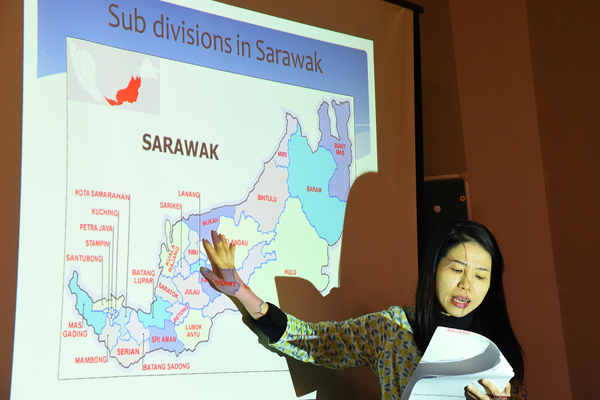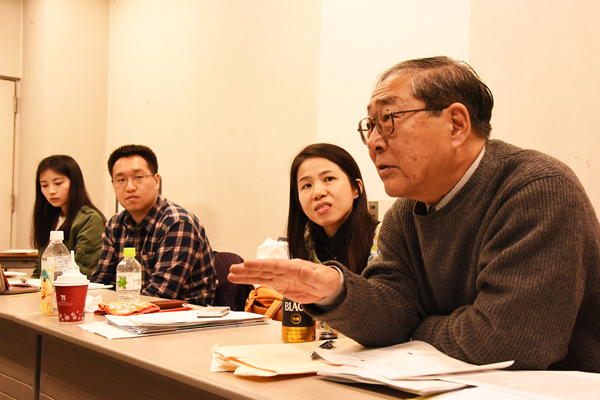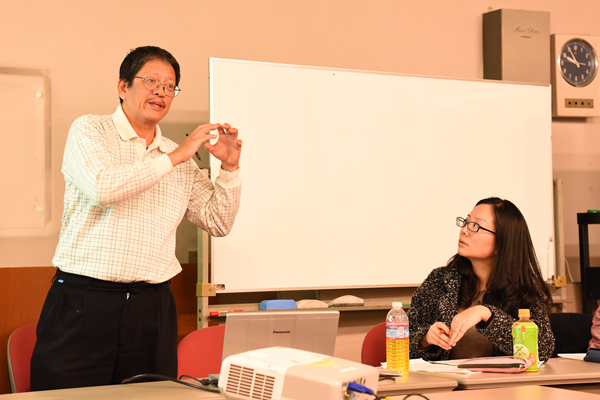
Dr Elena Chai from Unimas presents a paper on Community Allegiance to Temple: Communities in Sarawak.
BEFORE Sibu was established in 1862, its name was already in existence.
“Orang Sibu” referred to the Melanaus but the Minang (Fujian) people were among the earliest Chinese settlers in Sibu — as early as the 1860’s.
According to local historian Wong Meng Lei, after the migration from China that established the New Foochow Settlements along the Rajang River (Ensurai), Igan River and Sungei Merah (Seduan), agriculturists from the clan developed their villages during the rule of the Rajahs.
He pointed out that the Foochow migration in 1901 also included many who were Hin Huas, Nang Pings and Minangs.
“The Foochows were, in fact, not settled on Sibu island where the Minang people had already established a foothold and built shops,” he said in a paper presented at the Yamamoto International Workshop, organised by Tsukuba University, Japan, on Dec 5.
Wong, who is the director of Chinese Methodist Message and chairman of Publication Committee, World Federation Fuzhou Association, also emphasised while other Chinese emigrants brought their folk beliefs and temple customs to places like the US, Thailand and even India, the Foochowpioneers to Sarawak, led by Wong Nai Siong, brought Christianity from China.
It was the development of Christian churches in Sarawak that brought about social solidarity, he noted.
His paper titled Some Clarification about Chinese History of Sibu is based on his writings and research over the past 20 years.
It was his third presentation by invitation to a university audience in Japan.
His first paper —The Methodist Church Movement in Borneo — was delivered in 2011 and his second — Foochow and Hin Hua Migration to Sarawak — in 2013.
He also presented a paper at Fujian Normal University in Fuzhou in April 2014 and another at Huaqiao University, Xiamen. His topics included Foochow and Hin Hua Migration and Methodist Church History in Sarawak.
Wong said he was pleasantly surprised to discover during the international workshop that there are more than 100 Japanese researchers or scholars doing Borneo studies, adding that they are very well versed in the cultures, religions and ethnicities of Sarawak, Sabah and Kalimantan.
While in Japan, he also shared the topic — Sibu’s Foochow Migration – with students from at Hiroshima City University on Dec 7, at the invitation of Professor Iijima Noriko, just before they left for home.
To this group, he again emphasised that Sibu was a very unique Foochow migration destination.
“In Sibu, the Foochows who have become the majority have uniquely made the Christian church play this special role of social solidarity.”
Wong and Dr Elena Chai from Unimas were the only two foreign invited speakers at the International Workshop. Their sharings were well received by more than 100 participating Japanese professors, research scholars and academia.
Wong who often takes visitors on tours to churches and historical spots along the Rajang Valley, is a published author of more than 10 books on Christianity in Sarawak, Foochow and Hin Hua migrations to Sarawak, and other general academic and literary topics in the last 20 years.
While in Japan, he and his friend Steve Ling visited Aoyama Gakuin University, established by Methodist missionaries, Dora E Schoonmaker, Robert Samuel Maclay and Julius Soper.
In fact, Maclay was in Fuzhou as a missionary for more than 20 years. He translated the Bible into Foochow and collaborated with other missionaries to publish a Foochow dictionary.
Wong and Ling also visited Meiji University, founded in 1991 by the Presbyterian Church (US). There, he met Yuko Watanabe, Professor, Center for Liberal Arts, and Suh Jeong Min, assistant manager, Institute for Christian Studies.
Chinese temple culture
Chai was invited to present a paper on her special field — Hakka studies.
In 2010, she did her PhD at Tokyo University of Foreign Studies. Her main area of interest is ritual studies and her doctoral thesis is about marriage rituals among the Hakka Chinese in Sarawak.
Chai who lectures at Unimas, presented the first paper titled — Community Allegiance to Temple: Chinese Communities in Sarawak, Malaysia – at the workshop.
She brought a better understanding to her audience about the Chinese community in Sarawak, with regard to Chinese temple culture.
She stated that in almost every Chinese settlement, there is a Tua Pek Kong temple and as a result, there are 76 known Tua Pek Kong temples in Sarawak.
“The continuity of the temple culture, especially in sustaining and maintaining the well-being of the deity, mirrors the Chinese’s continual belief in their deity. Whether they are in town or in village, they maintain their temples well,” she noted.
“With a big population of Chinese (25 per cent of the total of 2.4 million people in Sarawak), the temple culture portrays communal expressions in varying degrees.”
Dr Chai said, adding that “there is no generalised Chinese community but distinctive Chinese communities in Sarawak”.

Prof Uchibori Motomitsu (right) expresses his views during the sharing session.
Sino-Japanese War
Four Japanese scholars also presented their papers at this International Workshop.
In his presentation titled Sibu Nanyang Chinese National Salvation Movement 1937-41, Assistant Professor of Tsukuba University, Dr Yamamoto Shin noted that when the Japanese attacked China, the overseas Chinese, led by Cheng Jia Geng, mobilised the contribution of funds to save China, emphasising the role of Foochow migrants in Sibu towards this end.
Tracing the history of Foochow migration from the time Wong Nai Siong brought them from Minqing and Gutian to Sibu, he noted two thirds were Christians, the majority being Methodists who were later managed by Rev James Hoover when Wong Nai Siong returned to China after three years in Sibu.
By 1937, the Foochows and other Chinese migrants were prosperous enough to contribute war funds to help relieve China.
The paper included details on the propaganda from China to the overseas Chinese such as through newsletters and movies. In Sibu, a local newspaper — Sibu News Daily (詩巫新聞日刊) — in its first publication on July 1, 1939, mentioned it would update the latest news from China and support the KMT to fight against Japan.
The representative from China in Sandakan, Sabah, Toh Hwan Lai(卓還來領事),in a report, mentioned various magazines, newsletters and songs were distributed and commonly sung among the Chinese societies.
He also said the capital of Sarawak did not respond as well as Sibu to the Salvation movement.
Dr Yamamoto pointed out that the Methodist Church in Sibu was actively involved in the Salvation movement and also acted as a venue for disseminating news to the villagers on the war in China.
Miura Tetsuya, Associate Professor of IKUEI Junior College, presented the fourth paper titled Memories of Japanese Military Administration: a comparison of the Ibans and the Kadazan-Dusuns.
He mentioned that in December 1941, the Japan military occupied Labuan, Jesselton (now KK) and Kuching — etc.
The strategy of Japanese military in Nanyang was originally to help the development and protect the resources of these places. The Japanese also wanted to cut off relationships between the overseas Chinese and the Mainland. So the Japanese army were usually more friendly to Indigenous people than the Chinese.
Dr Yamamoto’s field study garnered a lot of information on the Kadazan-Dusuns in Sabah and Ibans in Sarawak.
It showed the Japanese army were more friendly to the indigenous people whom they even employed.
The Japanese had wanted to divide the Indigenous people and the Chinese but it seemed to be a failure.
According to the feedback, the relationships between the Indigenous people and Chinese were good although the lives of the Chinese were difficult compared to the Indigenous people during the war.
The final paper, by Matsumura Toshio, Research Associate at Waseda University, was titled Dayak Politics in Anti-Chinese Demonstration of 1967, West Kalimantan, Indonesia.
He said the killings of 1965–1966 were an anti-communist purge following the failed coup by the Sept 30 Movement in Indonesia, adding: “Actually the communists were also influenced by the Sarawak illegal communist organisation — Pasukan Gerilya Rakyat Sarawak.
“They were in alliance with the Pasukan Rakyat Kalimantan Utara. Indonesian soldiers were forced to take action against the communists. The most widely accepted estimates were that more than 500,000 people were killed.”
Giving his comments, Wong (Meng Lei) said: “What is amazing is the fact that this scholar speaks Iban that we can understand. It’s awesome that scholars from so far away, doing in research in Kalimantan, have so much interest in the details of modern history happening in Borneo.”
The workshop was attended by more than 200 scholars, mainly with interests in Sarawak, in particular, and Borneo, in general. Many questions were asked and a lot of interest generated.
“This kind of academic exercise is very fruitful and scholars should be encouraged to participate so that more knowledge about Sarawak can be spread internationally. I thank the various Japanese universities for inviting me to speak,” Wong added.

Speakers and participants of the workshop.

Wong Meng Lei gives a talk on the Chinese in Sibu.
